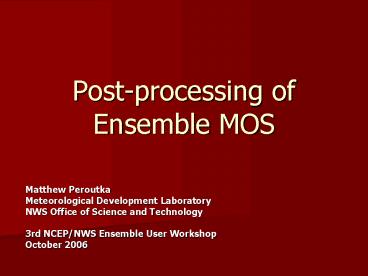Postprocessing of Ensemble MOS PowerPoint PPT Presentation
1 / 17
Title: Postprocessing of Ensemble MOS
1
Post-processing of Ensemble MOS
- Matthew Peroutka
- Meteorological Development Laboratory
- NWS Office of Science and Technology
- 3rd NCEP/NWS Ensemble User Workshop
- October 2006
2
Utility of Probabilities
- Probabilistic forecasts can be more useful to
users than non-probabilistic. - Not necessarily so.
- User must
- want to use
- be able to use
- actually use
3
Dichotomous vs. Quasi-continuous Weather Elements
- Dichotomous events are relatively simple.
- Disseminate a single probability to user.
- Examples
- Pcpn gt 0.01
- MinT lt 22 F
- Quasi-continuous case problematic.
- Concept, dissemination more difficult.
- Examples
- Temperature
- Wind Speed
- Ceiling Height
4
Temperature
- Quasi-continuousforecast and observed in
increments of 1 F / 0.1 C. - Wide range of values.
- Many potential users with diverse interests in
various portions of range. - It is not enough to set thresholds or define
ranges. We need to forecast probability function
(PDF, CDF, PPF).
5
Overall Goals(Characteristics of a Good
Probability Forecast)
- Unbiased (Compare E(X) to Obs)
- Reliable (Probability Integral Transform PIT
Histogram) - Skillful (Continuous Ranked Probability Score)
- Sharp (Credible Intervals)
- Overall shape of the distribution is informative.
6
Data Used
- Ensemble members (11) from North American
Ensemble Forecast System (0000 UTC) - Ensemble MOS (ENSMOS 0000 UTC)
- Operational MOS (0000 UTC)
- Verifying observations
- 1500 GFS MOS stations (CONUS and OCONUS)
- April 2004 through June 2006
7
Ensemble MOS
- MOS equations Applied to individual ensemble
members. - 11 separate ENSMOS text bulletins generated.
- Note that spread decreases with time projection.
- Box/whisker graphic at right from PSU.
8
Techniques
- ENSMOS Adjusted by SDe (EASe)
- Compute standard deviation of ensemble output
(SDe) and ENSMOS output (SDm). - Adjust spread of ENSMOS output accordingly.
- Use Kernel Density Estimation (KDE) to generate
PDF. - Probability Assessment using KDE, Ensembles, and
MOS (PAKEM) - Model relationship between forecast error and
ensemble forecasts. - Adjust spread of ensemble output accordingly.
- Debias adjusted values using operational MOS.
- Use Kernel Density Estimation (KDE) to generate
PDF.
9
Kernal Density Estimation
- Extrapolates PDF (blue line) from a sample of
data. - N kernel functions (red dashed lines) are
centered on data values (Gaussian functions in
this case).
10
Effect of KDE Spread or Window Parameter on
the Sharpness of Distribution
h 3.7
h 1.1
h 0.5
h 0.1
11
Forecast Error and Ensemble Forecasts
- Variables
- MAE is mean absolute error of operational MOS.
- SDe is standard deviation of model ensemble
temperature forecast. - Histograms record relationship between MAE and
SDe. - Red bars each contain 10 of the data.
- Green bars each contain 1 of the data.
- Cumulative density plotted below on same scale.
12
Forecast Error and Ensemble Forecasts
- Data imply a linear relationship for lowest
90-95 of the SDe values. - MAE values seem to flatten out for highest SDe
values. - Note changes in relationship with longer
projection times. - Linear regression yields a very weak relationship.
13
Results
- Reliability/Bias (PIT Histograms)
- Sharpness (50 Credible Interval CI50)
- Skill (Continuous Ranked Probability Score CRPS)
14
Reliability/Bias
- PIT Histo-grams for EASe PAKEM techniques.
- EASe under-dispersed and cold biased.
- PAKEM seems to do better in both.
15
Sharpness
- For each forecast distribution, find T75 and T25,
where P(TltTn) n. - CI50 T75 - T25.
- PAKEM yields larger CI values since forecasts are
spread more.
16
Skill
- CRPS integrates area between CDF and a perfect
forecast. - Perfect in this case is represented by a pulse
or heavyside function. - Need some standard (climatology, perhaps) for
comparison.
17
Comments
- Obviously, a work in progress.
- Efforts to combine existing MOS techniques with
ensemble output show promise. - Seems possible to create probabilistic forecasts
of temperature that are unbiased and reliable. - Already we see trade-offs between skill,
reliability, and sharpness.

